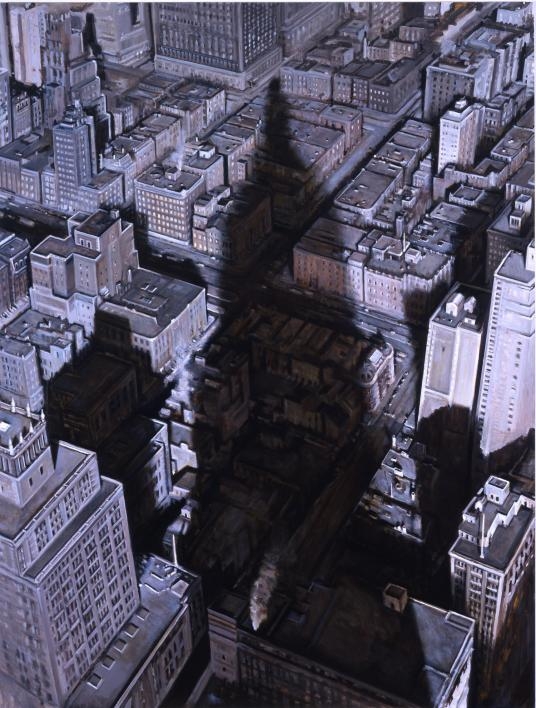“3 Five-Year Plans” surveys the work of painter Lawrence Gipe at the Arizona State University Art Museum

Lawrence Gipe, b. 1962 -
Panel No. 1 from Themes for a Fin de Siècle (Pride), 1989-90
Oil on panel, 72 x 72"
Photo courtesy of Herberger Institute for Design and the Arts.
TEMPE, Ariz. - Lawrence Gipe, the painter of rich imagery culled from war propaganda from the 1930s to the modern day, is the subject of a mid-career survey exhibition organized by Arizona State University Art Museum Director and Chief Curator Marilyn Zeitlin. Lawrence Gipe: 3 Five-Year Plans runs from March 10 to June 10. The artist lectures at the museum March 10 at noon.
At the age of 43, Gipe already has created a highly crafted body of work to national and international critical acclaim from publications such asArt Forum, Art News, Los Angeles Times, New York Times Magazine, Vanity Fair and others. He has had 35 solo exhibitions, received two NEA fellowships and curated several exhibitions. His work is held in many public collections including those of the Brooklyn Museum of Art, Los Angeles County Museum of Art, Rutgers University, Yale University Library, and in important private collections. Many of the works from these collections are in the exhibition. He currently teaches art history and studio art at the University of California Santa Barbara (UCSB) and at the Art Center in Pasadena.
Zeitlin has organized 20 of Gipe's large-scale paintings and multi-media works for 3 Five-Year Plans into three segments: 1990-95, 1995-2000 and 2000-2005.
In the exhibition's first segment, Gipe's paintings of factories, trains and aviation use visual and verbal languages to depict industrial technology and its social-political importance in Europe, the Soviet Union and the U.S. in the 1930s. The second segment of paintings further deconstructs propaganda with imagery derived from official Nazi era photography reflecting political and social ideology, art and technology. The third segment includes digital/traditional hybrid works that layer imagery of new technology and cultural sources to further explore the nature of propaganda.
"Gipe's work is remarkably relevant to the present, where we swim in a sea of political and commercial messages," says Zeitlin. "He awakens our doubts about those messages, with underlying humor to keep us looking while engaging our critical senses. At the same time, the quality of his painting delights the eye. It is a privilege to present the development of work that is at once so competent and intelligent."
Gipe has said of his work, "I'm interested in making paintings and installations that struggle to make a judgment and yet really end up talking about how those judgments are made."
Carol Diehl, in a critical review of Gipe's work in Art News, said "By dramatizing the already over-dramatized, Gipe exposes the fictions inherent in history and the pompous proclamations of authority."
A 64-page catalogue for the exhibition includes critical essays by Diehl and Zeitlin, an interview with Gipe by artist Julian La Verdiere and illustrations of the exhibition's works. The exhibition opening reception for members is March 10, 6-8 p.m. The public may join the museum at the door.
Coinciding with the exhibition is the museum's Forkosh Hirshman Art & Society Lecture Series which will feature Diehl as its guest lecturer on March 21.
The ASU Art Museum is part of the Herberger College of Fine Arts and has been called "the single most impressive venue for contemporary art in Arizona" by Art in Americamagazine. It is located on the southeast corner of Mill Avenue and 10th Street in Tempe. Exhibition hours are 10 a.m. - 9 p.m., Tuesdays and 10 a.m. - 5 p.m. Wednesday through Saturday. Admission is free. For more information, call 480-965-2787 or visit the museum online at http://asuartmuseum.asu.edu.
Media Contact:
Denise Tanguay
480.965.7144
denise.tanguay@asu.edu

